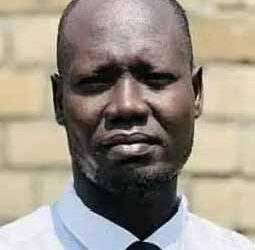By Albino Ayay Akol Dengdit
The people of present-day South Sudan went through what I would call the darkest corridors of history in their quest for self-determination, freedom, and independence for close to two centuries.
For over 190 years (1821–2011), Southern Sudanese endured immeasurable suffering meted out to them by colonial administrations and subsequent radical Islamic regimes in Khartoum.
Sudan was a free land until 1821, when it was first invaded by Turkish and Egyptian forces. A joint authority between Turkey (now Türkiye) and Egypt was established over Sudan thereafter. The Turco-Egyptian rule lasted from 1821 to 1885. The invasion was motivated by Muhammad Ali’s desire to acquire Sudanese slaves for his new army and the exploitation of the country’s natural resources. The joint colonial government oversaw slave trading and predatory commerce of all sorts imposed on indigenous peoples.
Although southern Sudan remained inaccessible in the early years of Ottoman-Egyptian rule in Sudan, the occupiers, in collaboration with northerners (Arabs), penetrated the region around 1827. Hence, the region was subjected to constant raids for ivory and slaves. This became worse when Khedive Ismail, the grandson of Muhammad Ali, assumed the throne in 1863. However, colonial forces faced strong local resistance, despite their superiority in terms of arms and training. The locals waylaid colonial expedition forces, inflicting heavy casualties on the invading army. It will surprise you to learn that the forces of Muhammad Ahmad bin Abdullah bin Fahal (Al Mahdi), who fought and defeated the Turco-Egyptian government, were comprised of Southerners. Unfortunately, a lot of our history has been concealed, distorted, or misrepresented altogether. For instance, the coming of Arabs to Sudan in the 12th century was altered to the “coming of people to Sudan.”
Nonetheless, the fall of the Turkish-Egyptian government was nothing to celebrate as Al Mahdi continued to mimic the colonialist legacy in his theocratic state in terms of imposing oppressive taxation and slavery. He reigned over Sudan from 1885 to 1899.
From 1896–1899, Britain and Egypt relaunched the conquest of Sudan under the pretext of liberating the Sudanese from Al Mahdi’s theocratic government. Though this was partly true, the real agenda was strategic military and economic interests. The Mahdist State under Abdallahi ibn Muhammad was trounced, leading to the establishment of an Anglo-Egyptian Condominium administration in Khartoum from 1899–1955. Horatio Herbert Kitchener became Governor General of Sudan in January 1899. Reginald Wingate succeeded him in December of that same year. Being a condominium government, the Egyptian and British flags were flown side by side.
By the 1920s, Sudan was effectively divided into two parts, North and South, through the Closed District Ordinance. Some historians report that Harold MacMichael, the then Civil Secretary, formulated this consequential policy. The policy rationale was to fast-track development in the South to bring it on par with the economically developed North. Northern Sudanese were barred from entering or working in the south, and the spread of Islam was effectively discouraged. The British made efforts to revitalize African cultures and traditions that the slave trade had disrupted. A directive issued in 1930 overtly stated that blacks in the southern provinces were to be considered a people distinct from northern Muslims and that the region should be prepared for eventual integration with British East Africa.
Around this same period, Sudanese nationalism began to arise, with some voices calling for unity and independence in the Nile Valley. The administration in Khartoum had to deal with increasing public agitation against colonialism. It might shock you to know that the first-ever movement for the independence of Sudan was orchestrated by a Southern Sudanese, Lt. Deng Tokmac (Ali Abdel Latif), who founded the United Tribes Society in 1921. In 1924, it morphed into the White Flag Society. Though this movement was suppressed, it set the stage for Sudanese nationalism and a revolution against oppression.
Meanwhile, the Closed District regime remained in force until it was repealed after the 1947 Juba Conference in favor of the “One Sudan Policy.” The Southern Chiefs were made to endorse the resolutions of the conference at face value. The majority of them were uneducated anyway. The conferees were assured that a post-independence government would safeguard southern political and cultural rights.
The British’s dereliction on this protectionist policy for Southern Sudan had serious implications for postcolonial Sudanese politics. In the south, the British were blamed for aborting this policy prematurely without realizing its intended objective of socio-economic and political parity. The Northerners, on the other hand, question the introduction of such a controversial policy in the first place, saying that it bears some responsibility for the deep-rooted divisions between the North and South and the eventual disintegration of the nation.
Rescinding the closed-door ordinance therefore meant northern Arab administrators were readmitted to southern posts, trade restrictions were lifted, Arabic was introduced as the medium of instruction, and Islamic faith was promoted in the south, just to mention but a few.
Moreover, the straw that broke the camel’s back was an attempt to transfer a unit of the Sudan Defense Force based in Torit to Khartoum. On August 18, 1955, this military unit (the Equatoria Corps), mostly composed of southerners, mutinied in Torit town, resulting in the deaths of at least 75 southerners and 361 from establishment forces. The insurrection quickly spread to Juba, Yei, Yambio, Maridi, and other areas.
That mutiny marked the beginning of the first liberation war against the dominance or marginalization of the Southern Sudanese people. A year later, on January 1, 1956, Sudan was declared an independent country, while the war was still raging in the southern part of the country. Dr. John Garang remarked during the signing of the CPA in 2005 that Sudan’s independence in January 1956 was incomplete because there was war in the South.
However, it was not until 1963 that Southern rebel factions organized themselves into one unified movement, the Anyanya, sometimes referred to as Anya Nya 1. Its political wing is the Southern Sudan Liberation Movement (SSLM). O’Balance wrote in 1977 that the period from 1955 to 1963 was simply one of guerilla survival, which lacked central command. The founding members of the Anyanya Movement included Joseph Oduho, Gordon Muortat Mayen, Joseph Lagu, George Akumbek, Julius Moroga, Severino Fuli, Aggrey Jaden, William Deng Nhial Mabuoc, and Fr. Saturnino Ohure Hilangi, among others.
The Anyanya Movement became a formidable rebel force in the south, supported by Ethiopia, Uganda, and Israel, whereas Great Britain, Egypt, and the Soviet Union (USSR) backed the central government.
Unfortunately, internal bickering and power wrangling rocked the Anyanya Movement not long after its formal establishment. Aggrey Jaden, the first leader of the movement, resigned in 1969 due to his frustration with the lack of cohesiveness within the movement. Gordon Muortat Mayen was then unanimously chosen to take over the movement. He renamed Southern Sudan the NILE REPUBLIC, with its citizens being called NILEANS. He rejected the name Southern Sudan on the basis that it was just a reference to a geographical zone, which had little relevance to the people of Southern Sudan.
A few years later, Gordon Muortat himself was overthrown by his own Chief of Staff, Joseph Lagu, in 1971. Many historians agree that had Gordon Muortat fought back to reclaim his seat, the peace accord of 1972 would not have been successfully negotiated, as the Movement would have been engulfed by internal conflicts.
The first war therefore ended with the signing of the Addis Ababa Agreement in 1972, which guaranteed autonomy for the southern region. The SSLM/Anyanya delegation was led by Ezboni Mondiri, while the government’s team was represented by Abel Alier Kwai. The negotiations were moderated by Burgess Carr, the then Secretary General of the All-Africa Conference of Churches. The agreement stipulated the establishment of a High Executive Council in the autonomous Southern Sudan. Abel Alier Kwai was appointed the first president of the regional government in 1972. He was later replaced by Joseph Lagu in 1978.
Nevertheless, some northern political groups and Muslim fundamentalists in Khartoum did not like the whole idea of giving Southern Sudan autonomy. The elites worked hard to dismantle the agreement. Finally, in 1983, President Gaafar Mohamed Al-Nimeiri abrogated the treaty, saying it was neither the Quran nor the Holy Bible. He declared Sudan an Islamic state under Sharia law, including the non-Islamic majority in the in the southern region. He also abolished the High Executive Council and divided Southern Sudan into three regions. He further gave orders for the transfer of forces of southern background to northern Sudan.
Consequently, on May 16, 1983, Battalion 105, under the command of Kerubino Kuanyin Bol, mutinied in Malual Chaat, Bor, with the simultaneous reaction of Battalion 104 in Ayod, under William Nyuon Bany. The second Sudanese civil war had thus effectively resumed. In the following month of June, Col. John Garang de Mabior was tasked by the Sudanese government to travel down south to convince his colleagues to abandon the rebellion, but he ended up joining them instead. He (Garang) became the Chairman and Commander-in-Chief of the SPLA/M, deputized by Cde. Kerubino Kuanyin Bol (who was said to have stepped down and nominated Garang), Cde. William Nyuon Bany, Cde. Salva Kiir Mayardit, the current President of South Sudan, and lastly, Cde. Arok Thon Arok. The above-named commanders formed the five permanent members of the SPLA/M Political-Military High Command. It is worth mentioning that the SPLM/A had some distractions from the early days of its inception. The new rebel movement had to deal with Anya Nya II forces (the remnants of Anyanya I) led by Akuot Atem and Gai Tut. The two groups had ideological differences in their approach to war. In the end, their differences were irreconcilable, leading to confrontations and the eventual defeat of the Anya Nya II faction. Some of their forces were absorbed into the ranks and files of the SPLA/M.
Thereon, the longest civil war in African history was fought. Roughly two million people died as a result of war, famine, and disease. The civilian death toll was one of the highest since World War II and was marked by numerous human rights violations, including slavery and mass killings. More than four million people were displaced. But in the face of an existential threat, the resolve of the Southern Sudanese to fight for their freedom did not falter. There was the utmost unity of purpose. Civilians joined the SPLA/M in their thousands. The movement grew stronger, capturing many towns and putting the regional capital, Juba, under siege.
Unfortunately, just like in the first war, the SPLA/M experienced a deadly internal split in 1991. That split was a major setback to the gains and momentum of SPLA/M. Dr. Riak Machar, along with Dr. Lam Akol, broke away from the SPLA/M mainstream.
Dr. John Garang described the split as a stab in the back, while Dr. Riak Machar termed it an ideological divergency. The SPLA/M Nasir Faction later negotiated and reached an agreement with the Sudanese government, known as the Khartoum Peace Agreement, in April 1997. The KPA was akin to the Addis Ababa Agreement, only that it contained the secession of the south from the north. It turned out to be a hoax, and Machar had to return to SPLA/M in 2002, three years before the signing of CPA.
Meanwhile, peace negotiations with the Sudanese government continued in Kenya. Eventually, the Comprehensive Peace Agreement was signed on January 9, 2005, ending Africa’s longest civil war. Gen. Lazarus Kipkurui Sumbeiywo was the Chief Mediator of the historical Sudanese IGAD-led peace process. The Troika countries were very influential in the successful negotiation, signing, and implementation of the Comprehensive Peace Agreement.
The CPA granted the right of self-determination to the people of Southern Sudan through an internationally supervised referendum after a six-year interim period. Simultaneously with the referendum on Southern Sudan, the people of Abyei were to cast a separate ballot, either to remain in Kordofan or return to Bahr el Ghazal, irrespective of the results of the Southern Sudan referendum. The people of Southern Kordofan, the Nuba Mountains, and the Blue Nile were to conduct popular consultations to renegotiate political, administrative, and constitutional arrangements with the central government.
Upon the signing of the CPA, Dr. John Garang was appointed as the First Vice President of the Republic and President of the Southern Sudan Government. Unfortunately, he was killed in a helicopter crash on July 30, 2005, barely 21 days after assuming office. Based on the hierarchy of the movement, the baton was automatically passed on to Gen. Salva Kiir Mayardit. He is commended for guiding and delivering the people of South Sudan to the promised land. Accordingly, the referendum was conducted on January 9, 2011. An overwhelming 99% of Southern Sudanese citizens voted in favor of seceding from the north. Finally, on July 9, 2011, Southern Sudan was declared an independent sovereign state, the Republic of South Sudan.
Notwithstanding, the Comprehensive Peace Agreement did not end comprehensively. Key protocols were left unresolved, chief among them being the official Abyei referendum, which was supposed to be held concurrently with that of Southern Sudan. This led the people of Abyei to organize their own referendum in October 2013, with an overwhelming 99.9% opting to join South Sudan. The other outstanding protocols include, but are not limited to, popular consultations for the peoples of Southern Kordofan and Blue Nile states, as well as the drawing of boundaries between the two sisterly nations.
And so, after gaining independence, the new nation was on course to catch up with the rest of the world in terms of infrastructural and human development; unfortunately, it plunged into a civil war in 2013. It was another devastating civil war that claimed thousands of lives, displaced millions of people, and destroyed infrastructure on a massive scale. Other factors to blame for instability include, but are not limited to, intercommunal conflicts, cattle raiding, and child abductions, especially in rural communities.
Nonetheless, the first post-independence civil war was quickly ended with the signing of the Agreement on the Resolution of the Conflict in South Sudan in August 2015. The government of National Unity was formed thereafter in April 2016. Dr. Riak Machar became the first vice president, and Dr. Wani Igga became vice president of the Republic. However, two months after the formation of the unity government, on July 8, 2016, fighting broke out in the Presidential Palace among the bodyguards of two leaders. BBC news correspondence would later describe it as “The J1 Dogfight.” Heavy casualties were inflicted on both sides. Dr. Machar mysteriously fled Juba westward, manoeuvring the thick equatorial rainforest towards the Democratic Republic of the Congo. On July 23, 2016, Gen. Taban Deng Gai was appointed through a Presidential Decree to replace Dr. Riak Machar, who was on the run. In effect, war had resumed once again in the new nation.
Nevertheless, there was hope that the agreement could be reinvigorated, subject to political will from the leaders of warring parties. Festus Mogae, the then Chairperson of the Joint Monitoring and Evaluation Commission, told journalists that the peace agreement was severely wounded but not dead. The region and international community mounted pressure on leaders to resuscitate the agreement. After serious negotiations and shuttle diplomacy for close to two years, the Revitalized Agreement on the Resolution of Conflict in South Sudan was signed in September 2018. However, its full implementation was at snail pace. The agreement stipulated that the president would be deputized by five vice presidents. In February 2020, Dr. Riak Machar, along with four other colleagues, were appointed as First Vice President and Vice Presidents of the Republic, respectively. The RTGoNU was mandated to fully implement the agreement and organize elections at the end of the transitional period. The parties had to extend the agreement for two more years, arguing that they needed more time to complete the outstanding issues in the agreement. Now, the country is currently on the verge of holding its first-ever post-independence elections in December 2024. It is hoped that elections will break the endless transition cycles, ushering the country into a new era of democratic governance, peace, development, and prosperity.
It was a journey of ages to reach the Promise Land, but much work is needed to make the Promise Land more promising. Aluta Continua!




